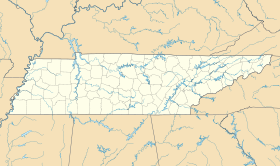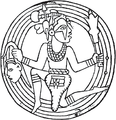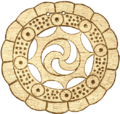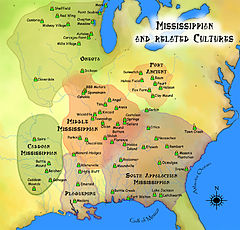- Castalian Springs Mound Site
-
Castalian Springs Mound Site
(40 SU 14)
Coordinates: 36°23′54.96″N 86°18′48.60″W / 36.3986°N 86.3135°W Location Country:  USA
USARegion: Sumner County, Tennessee Nearest town: Castalian Springs, Tennessee History Culture: Mississippian culture First occupied: 1100 CE Abandoned: 1450 Excavation and maintenance Responsible body: State of Tennessee Dates excavated: 1891, 1893, 1916-1917, 2005-2011, Notable archaeologists: William E. Myer, Kevin E. Smith Architecture Architectural styles: Platform mounds, burial mound, palisade, plaza The Castalian Springs Mound Site (40SU14)[1] (also known as Bledsoe's Lick Mound and Cheskiki Mound) is a Mississippian culture archaeological site located near the small unincorporated community of Castalian Springs in Sumner County, Tennessee. The site was first excavated in the 1890s and again as recently as the 2005 to 2011 archaeological field school led by Dr. Kevin E. Smith. A number of important finds have been associated with the site, most particularly several examples of Mississippian stone statuary and the Castalian Springs shell gorget held by the National Museum of the American Indian.
Contents
Site
The Castalian Springs site is the largest of four Mississippian mound centers on the eastern edge of the Nashville basin, located on a flood terrace of a tributary creek of the Cumberland River.[1] It was occupied from 1100 to 1450 CE.[2] The palisaded village and surrounding habitation area was approximately 40 acres (0.16 km2) in size and consisted of a dozen platform mounds, a burial mound, plaza and a number of dwellings and civic structures.[3] The site was first noted in the early 1820s by Ralph E.W. Earl, who did extensive digging at the site. He described a low earthen embankment with raised earthen towers enclosing 16 acres (0.065 km2), the remnants of what is now known to have been a wooden palisade. Earl also described the principal mound ( Mound 1) inside the enclosure as being a compound structure consisting of a rectangular platform 600 feet (180 m) long by 200 feet (61 m) wide and 13 feet (4.0 m) to 15 feet (4.6 m) in height and aligned in an east-west direction. On the western end of the platform was a conical shaped mound with a flattened top, approximately 18 feet (5.5 m) to 20 feet (6.1 m) in height.[4] On the southern side of the mound was a plaza, which was bordered on its eastern edge by a 120 feet (37 m) in diameter 8 feet (2.4 m) tall burial mound (Mound 2) and on its western edge by another large platform mound (Mound 3). Outside of the palisade to southwest on the banks of Lick Creek was a stone mound (Mound 4) 60 feet (18 m) in diameter and 5.5 feet (1.7 m), similar examples of which have been found at the Beasley Mounds and Sellars Indian Mound sites. Over the years since Earls first description Euro-Americans have plowed the area for agricultural purposes and consequently the main platform mound and a few raised impressions are all that are still visible of the embankment and the 12 platform mounds once contained within it. Scattered throughout the area archaeologists have also found stone box graves, mortuary caves and other features thought to be associated with the Castalian Springs site.[1] The karst terrain of the area produced numerous small caves, one of which is located a few hundred yards west of the Castalian Springs site. Known locally as the "Cave of the Skulls" (40SU126), this small cave was explored by Myer at sometime during one of his three excavation of the site.[5]
Excavations
In the early 1890s and again in 1916-1917, amateur archaeologist William E. Myer (later a “special archeologist” with the Smithsonian[6]) excavated parts of the site, including the stone box graves. He also excavated the large burial mound, which contained well over a hundred graves.[7] Myer discovered several artifacts containing S.E.C.C. imagery, including many shell gorgets which were later acquired by the Museum of the American Indian in 1926.[8]
The State of Tennessee purchased the site in 2005, and modern excavations were instituted by the Middle Tennessee State University. Dr. Kevin E. Smith conducted an archaeological dig school at the village site from 2005 through 2011.[4][9] The Castalian Springs Archaeological Project is a multi-year research project sponsored by the Department of Sociology and Anthropology at Middle Tennessee State University, the Bledsoe's Lick Historical Association and the Tennessee Division of Archaeology. Its stated objectives are to develop an initial understanding of the size and extent of the site, to develop trails and other facilities on the site without negatively impacting archaeological deposits, to give university students training in the methods and techniques of professional field and laboratory archaeology, and to emphasize to the public the value of archaeological research.[10]
Important finds
A number of stone statues have been dug up at the site, the first being sometime before 1823 when it is first mentioned. Since then several others have been found, including one believed to have been dug from the platform section of the main mound and several from one of the associated village areas.[1] In 1892 an etched stone tablet was discovered at the site by Myer. The 9 inches (23 cm) by 12 inches (30 cm) limestone tablet is engraved with symbolic imagery associated with the S.E.C.C., specifically the upper torso of a human figure ceremonially dressed as a raptorial bird with a sun symbol on its chest. The iconography is very similar to depictions of the falcon dancer found on repoussé copper plates excavated from locations across the Midwest and Southeast. The tablet was the second of only six such tablets that have been found in the Central Tennessee area.[11] Myer also found over thirty[12] engraved shell gorgets, several of which are now held by the N.M.A.I. The most important of the gorgets is carved in what is known as the Eddyville or Braden style, believed to have been associated with the Cahokia polity near Collinsville, Illinois. The gorget depicts a warrior figure holding a mace in his left hand and severed head in his right. The figure also has the Forked Eye Surround Motif, the Bellows apron motif and the Bi-Lobed Arrow Motif, all of which are associated with the S.E.C.C. Falcon dancer. Although the design is often shown with the figure upright, holes drilled in the edge of the gorget for its suspension as a neck ornament show it was meant to be seen with the figure oriented sideways, although it is as yet unclear what this may signify.[13] In 2005 a waterline replacement crew working on the right of way of U.S. Route 25 discovered an intact Cox style gorget carved from a dark gray shale. This artifact is one of a very few Cox style motifs utilized on a material other than marine shell.[12] The Castalian Springs site is also one of only three sites in Middle Tennessee where ceramic sherds of a type known as Angel negative painted have been found. This type of Mississippian culture pottery is typically associated with Angel Phase sites along the Ohio River.[14]
-
Engraved limestone tablet featuring a Falcon dancer
See also
- Bledsoe's Station
- List of Mississippian sites
- Southeastern Ceremonial Complex
References
- ^ a b c d Kevin E. Smith; James V. Miller (2009). Speaking with the Ancestors-Mississippian Stone Statuary of the Tennessee-Cumberland region. University of Alabama Press. pp. 68–77. ISBN 978-0-8173-5465-7. http://books.google.com/books?id=EO7TCPJymQYC&pg=PA55&lpg=PA55&dq=Castalian+Springs+Mound+site&source=bl&ots=4Wdg6OV_Lx&sig=-z4l8zRkTUupMVa6JZyRCOa4zsY&hl=en&ei=lKVcTZqsCML78AbkmaXLCQ&sa=X&oi=book_result&ct=result&resnum=4&ved=0CCwQ6AEwAzgK#v=onepage&q=Castalian%20Springs%20Mound%20site&f=false.
- ^ "Bledsoe's Lick Historical Association". http://www.bledsoeslick.com/. Retrieved 2011-02-17.
- ^ "Historical Background of Bledsoe's Lick". Bledsoe's Lick Archaeological Project. http://frank.mtsu.edu/~soc/anthropology/bledsoe/background.html. Retrieved 2011-02-17.
- ^ a b "Castalian Springs Mound". http://www.megalithic.co.uk/article.php?sid=14757. Retrieved 2011-02-17.
- ^ Smith, Kevin F.; Beahm, Emily L. (2009), Corrected provenance for the Long-nosed god mask from "A cave near Rogana, Tennessee", Southeastern Archaeology, http://findarticles.com/p/articles/mi_7737/is_200907/ai_n39230890/
- ^ "Tennessee treasures-Archaeologist William Myer". http://www.tennesseetreasures.net/index.php?option=com_content&task=view&id=110&Itemid=27. Retrieved 2011-02-17.,
- ^ Thruston, Gates Phillips (2010) [1897]. The Antiquities of Tennessee and the Adjacent States, and the State of Aboriginal Society in the Scale of Civilization Represented by Them: A Series of Historical and Ethnological Studies. NABU PR. ISBN 9781146351850. http://books.google.com/books?id=6kkBAAAAYAAJ&pg=PA352-IA3&lpg=PA352-IA3&dq=castalian+springs+warrior+gorget&source=bl&ots=xdsLFaKWGU&sig=mLQiNANMMY9kBiGe2rpP4S-5zOY&hl=en&ei=anldTa3lPIK78ga0uuGdCw&sa=X&oi=book_result&ct=result&resnum=1&ved=0CBMQ6AEwAA#v=onepage&q=castalian%20springs%20warrior%20gorget&f=false.
- ^ "National Museum of the American Indian-gorget detail". Smithsonian National Museum of the American Indian. http://www.nmai.si.edu/searchcollections/item.aspx?irn=162134&culid=2697&page=2. Retrieved 2011-02-17.
- ^ "Tennessee's Prehistory Revealed at Mineral Springs". http://www.megalithic.co.uk/article.php?sid=2146412516. Retrieved 2011-02-17.
- ^ "Castalian Springs Archaeological Project". http://frank.mtsu.edu/~kesmith/Castalian/CSAP2009.html. Retrieved 2011-02-18.
- ^ Loos, Ralph (January/February 2007), Hoyt B. Price, ed., Missing slab could unlock mysteries of past:Ancient artifact from east Nashville has unique etching, Stones and Bones, 49, The Alabama Archaeological Society, http://www.alabamaarchaeology.org/pubs/SB49-1-2007.PDF
- ^ a b Michael C. Moore, ed (Winter 2005). "Editors Corner". Tennessee Archaeology (Tennessee Council for Professional Archaeology) 2 (1). http://www.sitemason.com/files/kiNsWc/volume2issue1.pdf.
- ^ Muller, Jon. "Southeastern Ceremonial Complex"--the "Southern Cult"--a Powerpoint presentation on the web of my paper at the 2000 SAA meeting:Slide 7". http://anthro.siuc.edu/muller/SECC/sld007.htm. Retrieved 2011-02-17.
- ^ Kevin E. Smith; James V. Miller (2009). Speaking with the Ancestors-Mississippian Stone Statuary of the Tennessee-Cumberland region. University of Alabama Press. pp. 162–163. ISBN 978-0-8173-5465-7.
External links
- Daily journal entries by Dr Kevin E. Smith from excavations at Castalian Springs 2009-2011
- Three shell gorgets found at the site and on display at the N.M.A.I.-NMAI gorget 1, NMAI gorget 2, and NMAI gorget 3
- 1878 Castalian Springs map
- Ancient slabs unearthed in Midstate tell history of area
- Grant preserves ancient village in Castalian Springs
- Poster
 Pre-Columbian North America
Pre-Columbian North AmericaArchaeological cultures North American pre-Columbian chronology – Adena – Alachua – Ancient Pueblo (Anasazi) – Baytown – Belle Glade – Buttermilk Creek Complex – Caborn-Welborn – Calf Creek – Caloosahatchee – Clovis – Coles Creek – Deptford – Folsom – Fort Ancient – Fort Walton – Fremont – Glades – Glacial Kame – Hopewell (List of Hopewell sites) – Hohokam – Leon-Jefferson – Mississippian (List of Mississippian sites) – Mogollon – Monongahela – Old Cordilleran – Oneota – Paleo-Arctic – Paleo-Indians – Patayan – Plano – Plaquemine – Poverty Point – Prehistoric Southwest – Red Ocher – Santa Rosa-Swift Creek – St. Johns – Steed-Kisker – Tchefuncte – Tocobaga – Troyville
Archaeological sites Angel Mounds – Bandelier National Monument – The Bluff Point Stoneworks – Cahokia – Chaco Canyon – Casa Grande – Coso Rock Art District – Eaker – Effigy Mounds National Monument – Etowah Indian Mounds – Eva – Folsom Site – Fort Ancient – Fort Center – Gila Cliff Dwellings National Monument – Holly Bluff Site – Hopewell Culture National Historical Park – Kincaid Mounds – Kolomoki – Manitou Cliff Dwellings – Marksville – Meadowcroft Rockshelter – Mesa Verde – Moorehead Circle – Moundville – Mummy Cave – Nodena Site – Ocmulgee National Monument – Old Stone Fort – Parkin Park – Pinson Mounds – Portsmouth Earthworks – Poverty Point – Pueblo Bonito – Rock Eagle – Rock Hawk – Salmon Ruins – Serpent Mound – Spiro Mounds – SunWatch – Taos Pueblo – Toltec Mounds – Town Creek Indian Mound – WintervilleMiscellaneous Ballgame – Black drink – Buhl woman – Calumet – Chunkey – Clovis point – Container Revolution – Eastern Agricultural Complex – Eden point – Effigy mound – Falcon dancer – Folsom point – Green Corn Ceremony – Horned Serpent – Kennewick man – Kiva – Metallurgy – Mi'kmaq hieroglyphic writing – Medicine wheel – Mound builders – N.A.G.P.R.A. – Norse colonization of the Americas – Piasa – Pueblo dwellings – Southeastern Ceremonial Complex – Three Sisters agriculture – Thunderbird – Underwater panther
Categories:- Middle Mississippian culture
- Native American history of Tennessee
- Archaeological sites in Tennessee
- Geography of Sumner County, Tennessee
-
Wikimedia Foundation. 2010.







